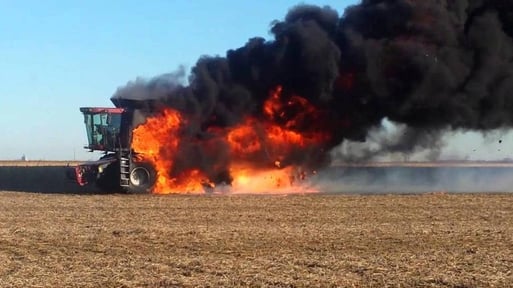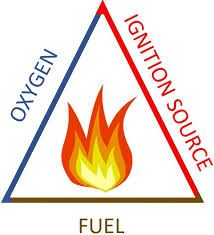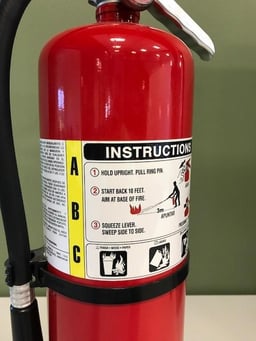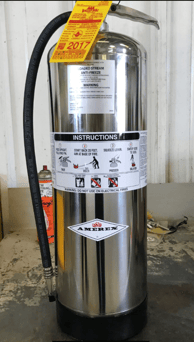As we prepare for harvest time, it's important to keep combine fire prevention as one of our priorities. Do you know the basics of fire, the different types of fire extinguishers, and best practices? Let's review.

Knowing the elements of fire will help you be proactive in preventing and extinguishing it. A common way of understanding these is the fire triangle.
Fire Triangle

To extinguish a fire, you need to neutralize one or more elements of the fire.
- Oxygen
- Fuel: material that keeps the fire burning; on machinery, this may be dry chaff, leaves, etc.
- Ignition Source/Heat Sources: possibilities include exhaust, worn bearings, belts, etc.
Fire Types
The type of fire is determined by what the fuel source is.
- Type A: Common combustible solids, wood, crop residue, and debris
- Type B: Burning liquids and gases, such as fuel, grease, hydraulic fluid
- Type C: Electrical equipment
Fire Extinguishers
| ABC Extinguisher | Water Extinguisher | |
| Fire Types | ABC | Only A |
| How does it work? | Works by blanketing the fuel to smother and remove the oxygen | Works by cooling the fuel below the temperature the fire can burn or reignite |
| How long will it last? | Lasts approx. 1 second per pound; i.e. a 10 pound extinguisher lasts 10 seconds | Lasts approx. 20 seconds per gallon; i.e. a 2.5 gallon extinguisher lasts 50 seconds |
| Horizontal Reach | 5 to 20 feet | 30 to 55 feet |
| Pros | Can be used for A, B, or C type fires | Horizontal reach allows for more distance and visibility, which is better for inexperienced operators |
| Photo |  |
 |
Fire Extinguisher Maintenance
- It is best to have a professional fire extinguisher company inspect your fire extinguishers annually.
- Make sure they are U.L. (Underwriters Laboratory) approved.
- Having fire extinguishers fully charged is as important as having one.
- Recharge partially discharged extinguishers by a professional.
Best Practices for Fire Safety on Combines/Tractors
Training
Training and preparation are key to being able to respond well in an emergency. It can be the difference between getting a fire put out quickly or the fire getting out your control. If you don't have experience using fire extinguishers, take the steps to learn because the discharge time for fire extinguishers is usually seconds. Many operators aren't prepared, leading them to use up precious time, discharge the contents too quickly, and be ineffective in putting the fire out. An easy way to remember what to do is the acronym PASS: Pull, Aim, Squeeze and Sweep.
Maintenance and Cleaning
Maintenance and cleaning are incredibly important components of fire prevention, particularly the engine area. Maintenance helps minimize the likelihood of mechanical or electrical failure, and consistently cleaning off harvest debris and crop residue reduces the potential fuel for a fire. Towards the end of harvest, it's easy to succumb to fatigue and grow lax with our maintenance, but we must stay vigilant! Combine fires frequently occur towards the end harvest because of operator fatigue and reduced maintenance.
Extinguisher Recommendation
The basic recommendation is to have two 10 pound ABC fire extinguishers on the combine, one that is mounted and can be accessed at ground level and one in or near the cab. However, our personal recommendation is that for the ground level extinguisher, you use a 20 pound ABC extinguisher instead of the 10 pound. The 20 pound extinguisher is a little more expensive, but we feel it's worth it, considering the value of everything you are protecting.
.jpg?width=220&name=IMG_2854%20(2).jpg)
.jpg?width=230&name=IMG_2873%20(2).jpg)
Call 911 First
If a fire does break out, the first step is to to call 911 before anything else. You may want to act immediately and try to extinguish it, but getting the fire department dispatched as soon as possible is important. Fire is unpredictable, and even if it appears to be a small, manageable fire, you may not be able to extinguish it. In that situation, having the fire department present will help prevent the fire spreading further on your property or your neighbor's property.
Personal Safety Comes First
If you are driving and suspect a fire, pull away from the crops and shut down the engine before you inspect. Check for your cell phone or communication devise, grab the fire extinguisher, and get out. Call for help. Make sure you and all your employees understand that tractor and combine fires burn very hotly, and can be deadly; a machine can be replaced and is not worth a life.
Closing Words
Nobody ever thinks that they'll be the farmer who watches helplessly as their combine burns, they lose the crop, and the fire spreads to neighboring properties. But clearly, it happens. This fall, take the necessary preparations to mitigate combine fires and make sure everyone Gets Home Safe.



